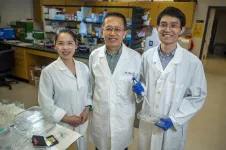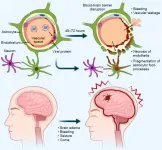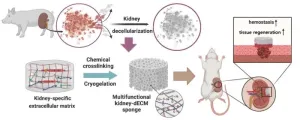(Press-News.org) Medical College of Georgia scientists report that a gene previously implicated in the development of atherosclerotic lesions in coronary arteries could be key to understanding why many people don’t benefit from the most used therapy for neovascular age-related macular degeneration (AMD), a leading cause of blindness.
AMD is a condition characterized by abnormal blood vessel growth in the back of the eye. It is highly prevalent in the elderly and people with diabetes, obesity, and many other chronic metabolic diseases. Excessive vascular growth damages the macula, the part of the eye that translates light into image signals.
Anti-VEGF therapy, which blocks vascular endothelial growth factor and keeps excessive blood vessel growth at bay, is usually the first line of defense.
But that treatment only works well for around a third of patients suffering from this form of AMD, says Dr. Yuqing Huo, MD, PhD, the Director of the Vascular Inflammation Program at MCG’s Vascular Biology Center. “The reason is that the excess vasculature is often accompanied by the growth of fibroblast cells,” he says.
Collagen and many other proteins produced by these fibroblast cells accumulate outside of the vascular cells and eventually lead to fibrosis or scarring in the eye. This keeps the excess vasculature from being suppressed by anti-VEGF treatments. “We show, for the first time in this study, that many fibroblast cells are actually produced by these excessive endothelial cells. We must find a way to prevent this from happening,” Huo says.
He and his team believe the answer lies in targeting the adenosine receptor 2A (Adora2a) — a G-protein-coupled adenosine receptor found in high levels in the brain, immune cells, and blood vessels. Adora2a has been reported to be crucial in modulating inflammation, myocardial oxygen consumption, and coronary blood flow. Adenosine, a metabolite produced by cells under conditions of stress, injuries, and lack of oxygen, can activate Adora2a to protect our body from injury.
But in excess, adenosine can lead to excessive blood vessel growth. In their current research, Huo and his colleagues found a high-level or persistent adenosine-activated Adora2a signal could transform endothelial cells, the luminal cells of the vasculature, into activated fibroblast cells and, eventually, cause fibrosis. Huo and his colleagues hypothesize that blocking this receptor can prevent that from happening.
Using genetically engineered mice that develop fibrosis in the backs of their eyes, researchers delivered an Adora2a agonist (KW6002), which binds to the receptor and blocks its function. “We also studied mice that had Adora2a removed from only the vascular endothelial cells,” says Qiuhua Yang, PhD, a postdoctoral fellow with Huo and the first author on this study. “All of these mice demonstrated decreased fibrosis in the eye.” These novel findings were reported and recently selected as the cover image for Science Translational Medicine.
“We have previously demonstrated that blocking Adora2a can reduce excessive blood vessel growth, which happens in the early stages of AMD,” says Yongfeng Cai, PhD, a postdoctoral fellow in Huo’s lab and a member of the research team. They now have an eye toward generating an antibody that could recognize Adora2A.
“The antibody could be delivered via an injection to the back of the eyes, an approach often used in eye clinics, to block the activation of adenosine to Adora2A,” Huo says. “An antibody could really block both excessive blood vessel growth, the early stage of AMD, and fibrosis, the late stage of AMD. Our findings indicate that blocking Adora2a can certainly target multiple stages of this disease, which might be much more efficient than current treatments.”
This research was supported by a National Institutes of Health K99 award to Dr. Qiuhua Yang and funds from the National Eye Institute.
Read the full study.
END
MCG scientists identify new treatment target for leading cause of blindness
2024-05-02
ELSE PRESS RELEASES FROM THIS DATE:
Promising new treatment strategy for deadly flu-related brain disorders
2024-05-02
Osaka, Japan – It might start simply, with a cough or sneeze…but in some cases, the flu virus can make its way to your brain, causing serious symptoms or even death through a disease known as influenza-associated encephalopathy (IAE).
Now, in a study published in Acta Neuropathologica, researchers have revealed that IAE may be caused by the virus entering the brain through a specific cell type, and have identified possible treatment strategies.
Although IAE is increasingly common, surprisingly little is known about ...
Scientists’ new approach in fight against counterfeit alcohol spirits
2024-05-02
In the shadowy world of counterfeit alcoholic spirit production, where profits soar and brands are exploited, the true extent of this illegal market remains shrouded.
Now scientists from the International Centre for Brewing and Distilling (ICBD) at Heriot-Watt University, in Edinburgh, Scotland, working alongside Dr John Edwards of Process NMR Associates, based in New York, are compiling a database to test, compare and log counterfeit spirits.
The research has featured in a paper, titled, Worldwide Illicit and Counterfeit ...
Cost-effective, high-capacity, and cyclable lithium-ion battery cathodes
2024-05-02
Charge-recharge cycling of lithium-superrich iron oxide, a cost-effective and high-capacity cathode for new-generation lithium-ion batteries, can be greatly improved by doping with readily available mineral elements.
The energy capacity and charge-recharge cycling (cyclability) of lithium-iron-oxide, a cost-effective cathode material for rechargeable lithium-ion batteries, is improved by adding small amounts of abundant elements. The development, achieved by researchers at Hokkaido University, Tohoku University, and Nagoya Institute of Technology, is reported in the journal ACS Materials Letters.
Lithium-ion batteries have become indispensable in modern life, used in a multitude ...
Artificial intelligence enhances monitoring of threatened marbled murrelet
2024-05-02
CORVALLIS, Ore. – Artificial intelligence analysis of data gathered by acoustic recording devices is a promising new tool for monitoring the marbled murrelet and other secretive, hard-to-study species, research by Oregon State University and the U.S. Forest Service has shown.
The threatened marbled murrelet is an iconic Pacific Northwest seabird that’s closely related to puffins and murres, but unlike those birds, murrelets raise their young as far as 60 miles inland in mature and old-growth forests.
“There are very few species like it,” said co-author Matt Betts of the OSU College of Forestry. “And there’s no ...
The solution to kidney bleeding and recovery lies within a hemostasis sponge, using the inherent capabilities of the kidneys
2024-05-02
Professor Dong-Woo Cho from the Department of Mechanical Engineering along with Jae Yun Kim, a PhD candidate, from the School of Interdisciplinary Bioscience and Bioengineering and Tugce Sen, a PhD student, from Department of Mechanical Engineering at POSTECH, teamed up with Professor Jae Yeon Lee from Daegu Haany University's Department of Companion Animal Health. Together, they crafted a material aimed at swiftly staunching kidney bleeding and facilitating wound recovery. Their research featured in the online edition of Biomaterials, an ...
Sylvester Cancer adding cellular therapy to its arsenal against metastatic melanoma
2024-05-02
MIAMI, FLORIDA (May 1, 2024) – Patients in South Florida with metastatic melanoma will soon have access to the first cellular therapy for this advanced form of skin cancer, following its recent approval by the Food and Drug Administration (FDA). The therapy, known as tumor-infiltrating lymphocyte therapy, or TIL, uses patients’ own immune cells to battle their cancer. It will be available to patients at Sylvester Comprehensive Cancer Center at the University of Miami Miller School of Medicine as South Florida’s only center offering ...
Study finds biomarkers for psychiatric symptoms in patients with rare genetic condition 22q
2024-05-02
A recent study led by UC Davis Health researchers provides new insights into the molecular changes linked to the rare genetic condition 22q11.2 deletion syndrome, or 22q. It found unique biomarkers that could identify patients with 22q who may be more likely to develop schizophrenia or psychiatric conditions, including psychosis, which is commonly associated with 22q. The research was published in the journal Metabolomics.
People with 22q are missing a piece of chromosome 22 that contains more than 30 genes. This loss can lead to a variety of health challenges, ...
Medical school scientist creates therapy to kill hypervirulent bacteria
2024-05-02
University of Central Florida College of Medicine researcher Renee Fleeman is on a mission to kill drug-resistant bacteria, and her latest study has identified a therapy that can penetrate the slime that such infections use to protect themselves from antibiotics.
In a study published recently in Cell Reports Physical Science, Fleeman showed that an antimicrobial peptide from cows has potential for treating incurable infections from the bacterium Klebsiella pneumoniae. The bacteria, commonly found in the intestines, is usually harmless. ...
New study supports psilocybin’s potential as an antidepressant
2024-05-02
Psilocybin - the active ingredient in “magic” mushrooms - is a more effective treatment for symptoms of depression than controls, providing further support for its potential as an antidepressant, suggests a study published by The BMJ today.
The researchers say the findings are encouraging but “further research is needed to clarify the factors that maximise psilocybin’s treatment potential for symptoms of depression.”
Depression affects an estimated 300 million ...
The Lancet Public Health: Global study reveals stark differences between females and males in major causes of disease burden, underscoring the need for gender-responsive approaches to health
2024-05-02
Global and regional analyses reveal persistent health differences between females and males across the 20 leading causes of disease burden (illness and death—quantified as health loss) over the past 30 years.
Overall, health loss is higher in males, particularly driven by premature death; but females, despite tending to live longer, endure higher levels of illness over their lives—underscoring the diverse and evolving health needs of men and women at different stages of their lives.
These health differences emerge in adolescence highlighting the importance of early interventions and measures to prevent the onset and exacerbation ...








